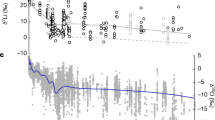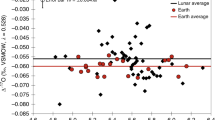Abstract
The snowball Earth hypothesis postulates that the planet was entirely covered by ice for millions of years in the Neoproterozoic era, in a self-enhanced glaciation caused by the high albedo of the ice-covered planet. In a hard-snowball picture, the subsequent rapid unfreezing resulted from an ultra-greenhouse event attributed to the buildup of volcanic carbon dioxide (CO2) during glaciation1. High partial pressures of atmospheric CO2 ( ; from 20,000 to 90,000 p.p.m.v.) in the aftermath of the Marinoan glaciation (∼635 Myr ago) have been inferred from both boron and triple oxygen isotopes2,3. These
; from 20,000 to 90,000 p.p.m.v.) in the aftermath of the Marinoan glaciation (∼635 Myr ago) have been inferred from both boron and triple oxygen isotopes2,3. These  values are 50 to 225 times higher than present-day levels. Here, we re-evaluate these estimates using paired carbon isotopic data for carbonate layers that cap Neoproterozoic glacial deposits and are considered to record post-glacial sea level rise1. The new data reported here for Brazilian cap carbonates, together with previous ones for time-equivalent units4,5,6,7,8, provide
values are 50 to 225 times higher than present-day levels. Here, we re-evaluate these estimates using paired carbon isotopic data for carbonate layers that cap Neoproterozoic glacial deposits and are considered to record post-glacial sea level rise1. The new data reported here for Brazilian cap carbonates, together with previous ones for time-equivalent units4,5,6,7,8, provide  estimates lower than 3,200 p.p.m.v.—and possibly as low as the current value of ∼400 p.p.m.v. Our new constraint, and our re-interpretation of the boron and triple oxygen isotope data, provide a completely different picture of the late Neoproterozoic environment, with low atmospheric concentrations of carbon dioxide and oxygen that are inconsistent with a hard-snowball Earth.
estimates lower than 3,200 p.p.m.v.—and possibly as low as the current value of ∼400 p.p.m.v. Our new constraint, and our re-interpretation of the boron and triple oxygen isotope data, provide a completely different picture of the late Neoproterozoic environment, with low atmospheric concentrations of carbon dioxide and oxygen that are inconsistent with a hard-snowball Earth.
This is a preview of subscription content, access via your institution
Access options
Subscribe to this journal
Receive 51 print issues and online access
$199.00 per year
only $3.90 per issue
Buy this article
- Purchase on Springer Link
- Instant access to full article PDF
Prices may be subject to local taxes which are calculated during checkout


 (p.p.m.v.) and Δ
17
O(O
2
) for 20% and 1% O
2
, assuming a modern value for O
2
residence time of 1,200 yr.
(p.p.m.v.) and Δ
17
O(O
2
) for 20% and 1% O
2
, assuming a modern value for O
2
residence time of 1,200 yr.

Similar content being viewed by others
References
Hoffman, P. F. & Schrag, D. P. The snowball Earth hypothesis: testing the limits of global change. Terra Nova 14, 129–155 (2002)
Kasemann, S. A., Hawkesworth, J. C., Prave, A. R., Fallick, A. E. & Pearson, P. N. Boron and calcium isotope composition in Neoproterozoic carbonate rocks from Namibia: evidence for extreme environmental change. Earth Planet. Sci. Lett. 231, 73–86 (2005)
Bao, H., Lyons, J. R. & Zhou, C. Triple oxygen isotope evidence for elevated CO2 levels after a Neoproterozoic glaciation. Nature 453, 504–506 (2008)
Shen, B. et al. Stratification and mixing of a post-glacial Neoproterozoic ocean: Evidence from carbon and sulfur isotopes in a cap dolostone from northwest China. Earth Planet. Sci. Lett. 265, 209–228 (2008)
McFadden, K. A. et al. Pulsed oxidation and biological evolution in the Ediacaran Doushantuo Formation. Earth Planet. Sci. Lett. 105, 3197–3202 (2007)
Jiang, G. et al. Organic carbon isotope constraints on the dissolved organic carbon (DOC) reservoir at the Cryogenian-Ediacaran transition. Earth Planet. Sci. Lett. 299, 159–168 (2010)
Guo, Q. et al. Carbon isotopic evolution of the terminal Neoproterozoic and early Cambrian: Evidence from the Yangtze Platform, South China. Palaeogeogr. Palaeoclimatol. Palaeoecol. 254, 140–157 (2007)
Ader, M. et al. A multilayered water column in the Ediacaran Yangtze platform? Insights from carbonate and organic matter paired δ13C. Earth Planet. Sci. Lett. 288, 213–227 (2009)
Hayes, J. M., Strauss, H. & Kaufman, A. J. The abundance of 13C in marine organic matter and isotopic fractionation in the global biogeochemical cycle of carbon during the past 800 Ma. Chem. Geol. 161, 103–125 (1999)
Kaufman, A. J. & Xiao, S. High CO2 levels in the Proterozoic atmosphere estimated from analyses of individual microfossils. Nature 425, 279–282 (2003)
Young, S. A., Saltzman, M. R., Bergström, S. M., Leslie, S. A. & Xu, C. Paired δ13Ccarb and δ13Corg records of Upper Ordovician (Sandbian-Katian) carbonates in North America and China: Implications for paleoceanographic change. Palaeogeogr. Palaeoclimatol. Palaeoecol. 270, 166–178 (2008)
Riccardi, A., Kump, L. R., Arthur, M. A. & D'Hondt, S. Carbon isotopic evidence for chemocline upward excursions during the end-Permian event. Palaeogeogr. Palaeoclimatol. Palaeoecol. 248, 73–81 (2007)
de Alvarenga, C. J. S., Santos, R. V. & Dantas, E. L. C-O-Sr isotopic stratigraphy of cap carbonates overlying Marinoan-age glacial diamictites in the Paraguay Belt, Brazil. Precambr. Res. 131, 1–21 (2004)
Corsetti, F. A. & Kaufman, A. J. Stratigraphic investigations of carbon isotope anomalies and Neoproterozoic ice ages in Death Valley, California. Geochim. Cosmochim. Acta 115, 916–932 (2003)
Kaufman, A. J., Hayes, J. M., Knoll, A. H. & Germs, G. J. B. Isotopic compositions of carbonates and organic carbon from upper Proterozoic successions in Namibia: stratigraphic variation and the effect of diagenesis and metamorphism. Precambr. Res. 49, 301–327 (1991)
Narbonne, G. M., Kaufman, A. J. & Knoll, A. H. Integrated chemostratigraphy and biostratigraphy of the Windermere Supergroup, northwestern Canada: Implications for Neoproterozoic correlations and the early evolution of animals. Geol. Soc. Am. Bull. 106, 1281–1292 (1994)
Knauth, L. P. & Kennedy, M. J. The late Precambrian greening of the Earth. Nature 460, 728–732 (2009)
Bristow, T. F. & Kennedy, M. Carbon isotope excursions and the oxidant budget of the Ediacaran atmosphere and ocean. Geol. Soc. Am. 36, 863–866 (2008)
Font, E., Trindade, R. I. F. & Nédélec, A. Detrital remanent magnetization in haematite-bearing Neoproterozoic Puga cap dolostone, Amazon craton: a rock magnetic and SEM study. Geophys. J. Int. 163, 491–500 (2005)
Crafts-Brandner, S. J. & Salvucci, M. E. Rubisco activase constrains the photosynthetic potential of leaves at high temperature and CO2 . Proc. Natl Acad. Sci. USA 97, 13430–13435 (2000)
Huber, R., Huber, H. & Stetter, K. O. Towards the ecology of hyperthermophiles: biotopes, new isolation strategies and novel metabolic properties. FEMS Microbiol. Rev. 24, 615–623 (2000)
Corsetti, F. A., Olcott, A. N. & Bakermans, C. The biotic response to Neoproterozoic snowball Earth. Palaeogeogr. Palaeoclimatol. Palaeoecol. 232, 114–130 (2006)
Elie, M., Nogueira, A. C. R., Nédélec, A., Trindade, R. I. F. & Kenig, F. A red algal bloom in the aftermath of the Marinoan snowball Earth. Terra Nova 19, 303–308 (2007)
Goericke, R. & Fry, B. Variations of marine plankton δ13C with latitude, temperature, and dissolved CO2 in the world ocean. Glob. Biogeochem. Cycles 8, 85–90 (1994)
Rost, B., Riebesell, U., Burkhardt, S. & Sültemeyer, D. Carbon acquisition of bloom-forming marine phytoplankton. Limnol. Oceanogr. 48, 55–67 (2003)
Werne, J. P. & Hollander, D. J. Balancing supply and demand: controls on carbon isotope fractionation in the Cariaco Basin (Venezuela) Younger Dryas to present. Mar. Chem. 92, 275–293 (2004)
Popp, B. N. et al. Effect of phytoplankton cell geometry on carbon isotopic fractionation. Geochim. Cosmochim. Acta 62, 69–77 (1998)
Finkel, Z. V. et al. Phytoplankton in a changing world: cell size and elemental stoichiometry. J. Plankton Res. 32, 119–137 (2010)
Balci, N., Shanks, W. C., Mayer, B. & Mandernack, K. W. Oxygen and sulfur isotope systematics of sulfate produced by bacterial and abiotic oxidation of pyrite. Geochim. Cosmochim. Acta 71, 3796–3811 (2007)
Rye, R. & Holland, H. D. Paleosols and the evolution of atmospheric oxygen: A critical review. Am. J. Sci. 298, 621–672 (1998)
Li, C. et al. A stratified redox model for the Ediacaran ocean. Science 328, 80–83 (2010)
Zeebe, R. E. & Wolf-Gladrow, D. CO2 in Seawater: Equilibrium, Kinetics, Isotopes (Elsevier Oceanography Series, 65, 2001)
Sheppard, S. & Schwarcz, H. Fractionation of carbon and oxygen isotopes and magnesium between coexisting metamorphic calcite and dolomite. Contrib. Mineral. Petrol. 26, 161–198 (1970)
Mook, W. G., Bommerson, C. J. & Staberman, W. H. Carbon isotope fractionation between dissolved bicarbonate and gaseous carbon dioxide. Earth Planet. Sci. Lett. 22, 169–176 (1974)
Royer, D. L., Berner, R. A. & Beerling, D. J. Phanerozoic atmospheric CO2 change: evaluating geochemical and paleobiological approaches. Earth Sci. Rev. 54, 349–392 (2001)
Laws, E. A., Popp, B. N., Bidigare, R. R., Kennicutt, M. C. & Macko, S. A. Dependence of phytoplankton carbon isotopic composition on growth rate and [CO2]aq: Theoretical considerations and experimental results. Geochim. Cosmochim. Acta 59, 1131–1138 (1995)
Pancost, R. D., Freeman, K. H. & Wakeham, S. G. Controls on the carbon-isotope compositions of compounds in Peru surface waters. Org. Geochem. 30, 319–340 (1999)
Weiss, R. F. Carbon dioxide in water and seawater: the solubility of a non-ideal gas. Mar. Chem. 2, 203–215 (1974)
Béhar, F., Beaumont, V., De, H. L. & Penteado, B. Rock-Eval 6 technology: performances and developments. Rev. Inst. Fr. Pet. 56, 111–134 (2001)
Acknowledgements
We thank the Geochemistry division of IFP Energie nouvelle for performing Rock-Eval analyses. The work benefited from discussions with M. Bonifacie, G. LeHir, G. Paris and H. Strauss. Research was supported by a French MRT doctoral fellowship and a SETSI grant to P.S., and two INSU (SYSTER) grants to M.A.. R.I.F.T. and A.C.R.N. were supported by the INCT-Geociam programme, and by FAPESP and CNPq grants. J.L. was supported by the NASA Astrobiology Institute under cooperative agreement NNA09DA76 to the Penn State Astrobiology Research Center. This is IPGP contribution 3211.
Author information
Authors and Affiliations
Contributions
M.A. and R.I.F.T. conceived the work. P.S., M.A., R.I.F.T. and A.C.R.N. did the sampling. P.S., M.A., R.I.F.T. and P.C. wrote the paper and most of the Supplementary Information. P.S. carried out carbon isotope analyses. P.S. and M.E. did molecular organic geochemistry analyses and wrote the related Supplementary Information. M.A. and M.E. wrote Supplementary Information corresponding to the Rock-Eval data. J.L. performed triple-oxygen modelling and wrote the corresponding parts of the main text and Supplementary Information. A.C.R.N. organized the field work and contributed the geological setting of samples. All authors discussed results and contributed to the manuscript.
Corresponding author
Ethics declarations
Competing interests
The authors declare no competing financial interests.
Supplementary information
Supplementary Information
The file contains Supplementary Text, Supplementary Figures 1-11 with legends, Supplementary References and Supplementary Tables 1-2. (PDF 1947 kb)
Rights and permissions
About this article
Cite this article
Sansjofre, P., Ader, M., Trindade, R. et al. A carbon isotope challenge to the snowball Earth. Nature 478, 93–96 (2011). https://doi.org/10.1038/nature10499
Received:
Accepted:
Published:
Issue Date:
DOI: https://doi.org/10.1038/nature10499
This article is cited by
-
Carbonaceous material in Larji–Rampur window, Himachal Himalaya: Carbon isotope compositions, micro Raman spectroscopy and implications
Journal of Earth System Science (2021)
-
Multiple sulfur isotope evidence for massive oceanic sulfate depletion in the aftermath of Snowball Earth
Nature Communications (2016)
-
Comprehensive diagnostic review of the 13C-enriched crude oils exemplified by TD2Є and TZ62S in Tarim Basin, NW China
Chinese Journal of Geochemistry (2015)
-
Interpreting carbonate and organic carbon isotope covariance in the sedimentary record
Nature Communications (2014)
Comments
By submitting a comment you agree to abide by our Terms and Community Guidelines. If you find something abusive or that does not comply with our terms or guidelines please flag it as inappropriate.



